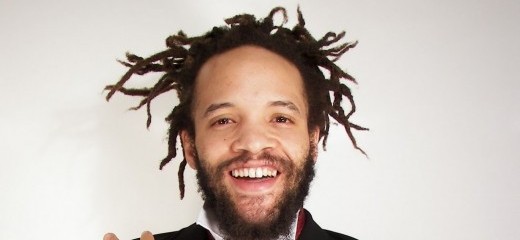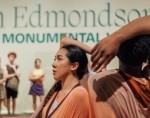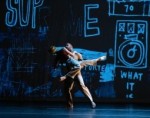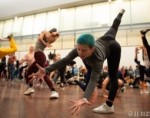
Tapping in Space: A Conversation
By Patricia Graham and Debbie Shapiro
Patricia Graham: You’ve seen Savion Glover perform a couple of times before tonight’s presentation, Dance Space. Did you perceive an evolution in his work as an artist this time?Debbie Shapiro: I can’t say that I did, which isn’t necessarily a problem. What Glover exudes through mere endurance, expansiveness, and rhythmic experimentation has been consistent throughout every performance I've seen. Previously I've seen him interact with live collaborations like music, or other dancers. This time he used his gift in conversation with lighting, set, and sound design. Since this was the first time I truly saw him perform solo I felt like the addition of the conceptual design added more
of an "impurity" to his art than anything else-- particularly because of the sightlines. Glover's feet were hidden from the audience by the angle of the platform he was dancing on.
How did the obstructed view of Glover's feet, seemingly hidden to us by design, affect your experience of the work, noting that this was your first time seeing him perform?
PG: I struggled to connect with him; perhaps my difficulty lay in my own expectations, but I wasn’t getting much kinesthetic communication for the first third of the concert. I reflected on the particularity of the tapper as someone who produces both sound and vision. Seeing how they make the sound, and the ways that works through the body, is a deep pleasure of the form. Although tap dancers frequently register for me like jazz musicians, the medium is still the dancing body.
Do you think Glover is expanding how we perceive tap dance and the milieu it typically evokes by constantly recontextualizing his work? Or not really??? Does the context fundamentally affect the content of his performance?
DS: I absolutely think he's expanded the form already. Does he continue to break boundaries? I don't know. I sometimes think about tap as the slowest of dance forms to progress, even more so than ballet. I often think of Savion Glover as someone who orchestrates surprising collaborations, however. I remember when he tapped to all four movements of "The Four Seasons" in front of a live string quartet. That was exciting, and really illuminated the virtues of both the classical sounds and his relaxed, but righteous body-instrument in new ways. In the case of Dance Space I certainly think the design concept, particularly the looping playback of taps and the dramatic twilight wall provided a new context for what he does. On one hand, it was the spectacle version (this piece was commissioned to fit the 2013 theme of the Philadelphia International Festival of the Arts) of a Savion show, and on the other, it was the next level of tap: dis-embodiment, or stimulating the audience's senses through scene and sound alone, demoting the physical body to something less interesting to watch.
What was your response to the design concept? Did you find it transported you to an other-worldly space? Or distracted from the actual dancing?
PG: I was transported to mystery land… the mystery of wondering what I was watching.
Glover entered a small platform high above the Academy stage, surrounded by twinkling “stars,” his dance space ringed by four speakers on clunky stands—more garage band than cosmic. He focused intently down and to his left, a dimly lit figure making vague movements. I would not have known I was watching someone tap dancing if my program and ticket didn’t inform me. If the idea is to stimulate the audience without the dancing body then bring it on. This particular set was more distraction than inspiration. Let’s call it a work in progress: maybe he’ll stick with his original idea and experiment with the theatrical elements down the road.
As the work progressed the lighting shifted and Glover brought his own physical presence forward. He beat out music with his feet for a solid hour, intensifying the heat and emotional storytelling as it progressed: a display of virtuosic muscle, including a shout-out to the ancestors, while perched atop a starry birthday cake installation.
The program notes explained that Glover would “tap through the darkness, drawing people closer to a connection with the early universe.” He expresses this theme through his own limitless inventions. For me, it was when he entered the piece as a dancer that I could connect with his infinite rhythm.
Dance Space, Savion Glover, The Academy of Music, March 30, 2013, www.pifa.org
By Patricia Graham
April 19, 2013







